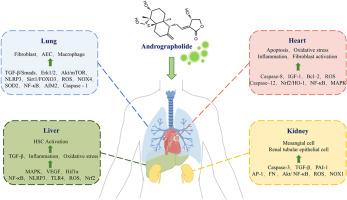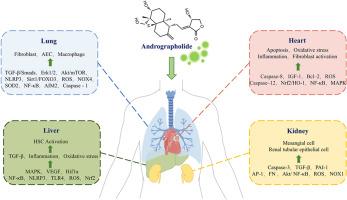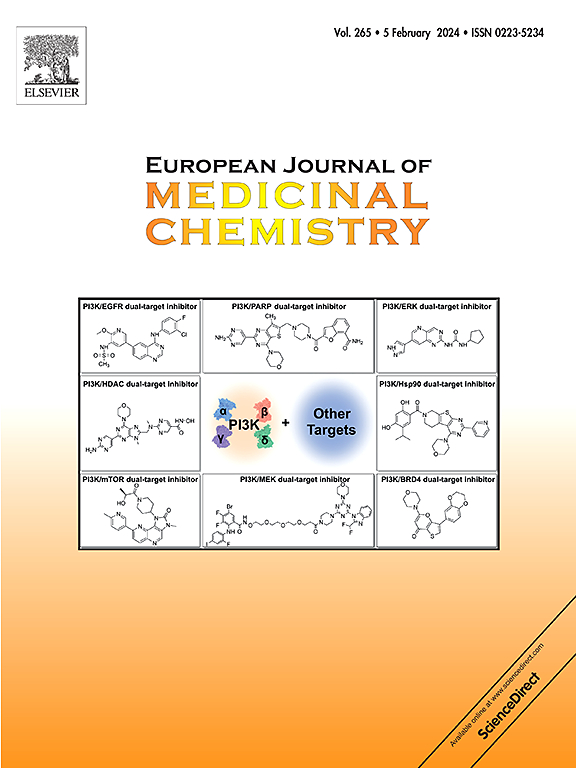穿心莲内酯:一种很有前景的器官纤维化治疗剂
IF 6
2区 医学
Q1 CHEMISTRY, MEDICINAL
引用次数: 0
摘要
纤维化是许多器官慢性病的终末病理,其特征是细胞外基质蛋白过度积累。这些变化会影响器官功能,最终导致器官衰竭。尽管在过去几十年中,人们在理解导致纤维化的分子途径方面取得了重大进展,但仍然缺乏有效的、已获批准的临床疗法。穿心莲内酯是一种二萜类化合物,主要从穿心莲的地上部分分离纯化而来,具有清热、解毒、抗菌、消炎等功效。深入的研究逐渐证实了穿心莲的抗癌、抗氧化、抗病毒等功效,从而对多种疾病起到预防和治疗作用。在过去几年中,越来越多的研究结果表明,安络血通过作用于转化生长因子-β/小母抗截瘫蛋白、丝裂原活化蛋白激酶、核因子-E2相关因子2、核因子卡巴-B和其他信号分子,抑制炎症、氧化应激、上皮-间质转化、成纤维细胞活化和胶原堆积,从而在各种器官中发挥抗纤维化作用。本综述汇编了有关 Andro 在体外和体内组织和细胞模型中抗纤维化影响的研究结果。重点是 Andro 对器官纤维化相关疾病的潜在治疗效果。简要讨论了有关 Andro 药代动力学、毒性和生物利用度的现有研究和前沿技术,为加速其临床转化和采用提供证据。本文章由计算机程序翻译,如有差异,请以英文原文为准。


Andrographolide: A promising therapeutic agent against organ fibrosis
Fibrosis is the terminal pathology of chronic illness in many organs, marked by excessive accumulation of extracellular matrix proteins. These changes influence organ function, ultimately resulting in organ failure. Although significant progress has been achieved in comprehending the molecular pathways responsible for fibrosis in the last decades, effective and approved clinical therapies for the condition are still lacking. Andrographolide is a diterpenoid isolated and purified mainly from the aboveground parts of the Andrographis paniculata plant, which possesses good effects of purging heat, detoxifying, antibacterial and anti-inflammatory. In-depth research has gradually confirmed the anticancer, antioxidant, antiviral and other effects of Andro so that it can play a preventive and therapeutic role in various diseases. Over the past few years, an increasing number of research findings have indicated that Andro exerts antifibrotic effects in various organs by acting on transforming growth factor-β/small mother against decapentaplegic protein, mitogen-activated protein kinases, nuclear factor-E2-related factor 2, nuclear factor kappa-B and other signalling molecules to inhibit inflammation, oxidative stress, epithelial-mesenchymal transition, fibroblast activation and collagen buildup. This review presents a compilation of findings regarding the antifibrotic impact of Andro in tissue and cell models in vitro and in vivo. Emphasis is placed on the potential therapeutic benefits of Andro in diseases related to organ fibrosis. Existing studies and cutting-edge technologies on Andro pharmacokinetics, toxicity and bioavailability are briefly discussed to provide evidence for accelerating its clinical conversion and adoption.
求助全文
通过发布文献求助,成功后即可免费获取论文全文。
去求助
来源期刊
CiteScore
11.70
自引率
9.00%
发文量
863
审稿时长
29 days
期刊介绍:
The European Journal of Medicinal Chemistry is a global journal that publishes studies on all aspects of medicinal chemistry. It provides a medium for publication of original papers and also welcomes critical review papers.
A typical paper would report on the organic synthesis, characterization and pharmacological evaluation of compounds. Other topics of interest are drug design, QSAR, molecular modeling, drug-receptor interactions, molecular aspects of drug metabolism, prodrug synthesis and drug targeting. The journal expects manuscripts to present the rational for a study, provide insight into the design of compounds or understanding of mechanism, or clarify the targets.

 求助内容:
求助内容: 应助结果提醒方式:
应助结果提醒方式:


